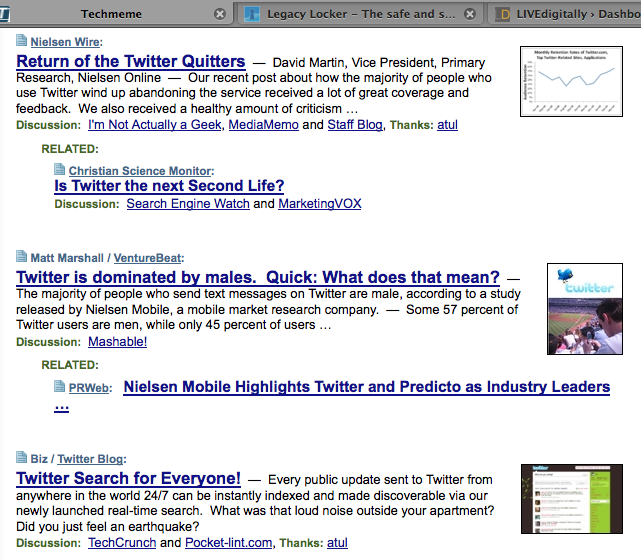 I’ve written in the past regarding why I gave up on mobile email, and have recently entered quite a few entertaining discussions on the topic. In a nutshell, I feel the “mobile email lifestyle” is generally a bad one, typically causing much higher stress levels in people.
I’ve written in the past regarding why I gave up on mobile email, and have recently entered quite a few entertaining discussions on the topic. In a nutshell, I feel the “mobile email lifestyle” is generally a bad one, typically causing much higher stress levels in people.
Now before everyone reading this on a BlackBerry jumps down my throat, there certainly are some times when mobile email is useful, helpful, and productive. Here’s the list:
- Sitting at your gate/otherwise waiting for a flight (but not, of course, once they’ve told you to turn off your phone, because as of that point you are just being a jerk by leaving it on. yup, that’s right, a big jerk)
- Waiting for some big deal to close (sorta – you really could do this with the phone, but I’m sure there are times when it would be necessary to have the email interaction)
- Sitting at dinner with really close friends/family
I’m sure there’s a few more exceptions that I’m not thinking of, and I’m okay with that. For the most part, I see people with BlackBerries and iPhones checking email all. the. time. Sure it’s annoying to those of us trying to spend any time with these people, but bad manners are probably just the most superficial of issues.
Constantly “on call”
When you sport a mobile email device, and reply to emails at all hours of the day, night, weekend, etc, you effectively say to your coworkers “I’m always available.” And by being always available, it becomes harder and harder for you to decide not to be available. Which leads to bosses/clients/peers sending in emails, expecting near-instant turnaround. Which effectively means you can get in trouble just by not checking email during dinner. Personally, I don’t like the idea that “important work stuff” happens at all hours – it doesn’t. And if you aren’t a doctor, firefighter, cop, or other person whose work truly happens at all hours, trust me, you can skip email tonight.
Less responsive to non-essential emails
BlackBerry people love to talk about how easily they can check email, anytime, anywhere. But they tend to do a much worse job at following through with non-essential emails. And, since those emails got marked as read right away, they tend to fall to the bottom of the priority list when the user actually gets to a computer. This is all compounded by the aforementioned issue that we know you read the emails we sent! Let’s be totally clear here: if you have a BlackBerry or iPhone, we know you get *all* email, and we know you check it right away. Lost emails are BS, it’s readily apparent that you are actively choosing not to respond to us.
Introduce work time during personal time
It’s not just that you are checking emails while we’re eating dinner, the distraction factor is just a part of it. It’s that those emails have impact on you and your mood. And let’s face it, if you are checking emails all evening long, odds are pretty good something will tumble into the inbox that will cause you more stress. So much for our happy evening, as you are now preoccupied with your work problem. There’s obviously the counterpoint here about getting some great news, like closing a deal, etc, but those are few and far between (and are much more fun on the phone anyway). Nothing like finishing up a meal with Mr Grumpypants who just found out some deal isn’t going to close.
Did I mention the bad manners?
I get that we live in the rapid-fire, constant interruptive, crazy overly connected world. But there is no debate that pulling out a gadget and reading an email while you are engaged in conversation is rude. Always. Even if there’s a lull in the chat, it’s not an excuse. Hang on a sec.
Sorry, I was checking email on my phone while you were waiting for me to finish typing. Get the point?

 It’s with tremendous pride and excitement that I use my first blog post in over a month to announce the launch of
It’s with tremendous pride and excitement that I use my first blog post in over a month to announce the launch of 


 Community-powered development and brainstorming is an interesting challenge. On one hand, you get exposure to more ideas and concepts than you can possibly get from an individual or small team. On the other hand, the signal-to-noise ratio rapidly gets out of control, and depending on the level of empowerment, you get clumsy, hard-to-use, yet feature-rich products. When I read about the
Community-powered development and brainstorming is an interesting challenge. On one hand, you get exposure to more ideas and concepts than you can possibly get from an individual or small team. On the other hand, the signal-to-noise ratio rapidly gets out of control, and depending on the level of empowerment, you get clumsy, hard-to-use, yet feature-rich products. When I read about the  Next, we have a fundamental cost/performance issue. I don’t think you need to be Jonathan Ives to say “people want lightweight, thin, exceptionally well-styled computers that are feature-rich and inexpensive”. Draw a triangle with size/weight, features, and cost onto the axes (clumsily drawn to the right using
Next, we have a fundamental cost/performance issue. I don’t think you need to be Jonathan Ives to say “people want lightweight, thin, exceptionally well-styled computers that are feature-rich and inexpensive”. Draw a triangle with size/weight, features, and cost onto the axes (clumsily drawn to the right using